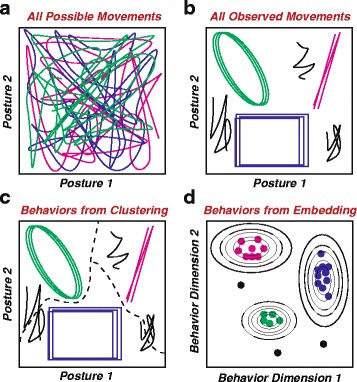Fig. 1.

Approaches for identifying stereotyped movements. a Representation of all of the movements an animal could theoretically make. For instance, each line could be the dynamics of two joint angles, say, the bending of a knee and an ankle, or another set of postural variables over time. Although an animal could potentially move with any of these postural trajectories, many of the motions here would be only rarely performed. b How we observe most animals to move. Specifically, they use a relatively small portion of their potential behavioral repertoire (stereotyped behaviors, colored lines) along with a few instances of less-commonly-observed ones (non-stereotyped behaviors, black lines). c One way to isolate stereotyped behaviors is to break-up the observed trajectories into clusters (denoted by dashed lines). d An alternate means of identifying stereotyped behaviors is to transform the dynamics in such a way that, for instance, each time one of the trajectories in b is performed, a dot is placed using a low-dimensional embedding to a different space. Similar trajectories are mapped near each other (dots), and stereotyped behaviors could be identified as peaks in the density contours (lines) of this map
